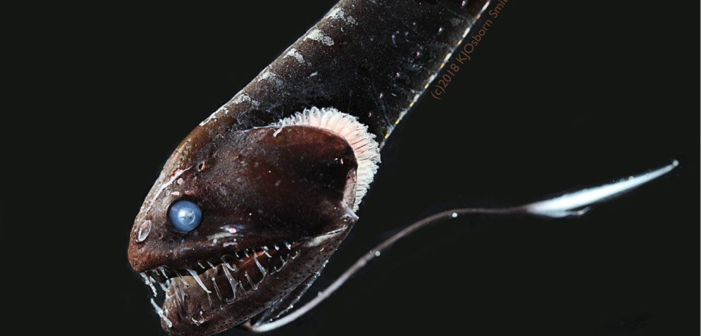Here’s an offbeat, really fun story from Smithsonian Magazine about the top ten ocean stories of 2020, covering everything from a beaked whale that set a record for the longest dive by a marine mammal (three hours and 42 minutes), to the first look at a Ram’s Horn Squid (who knew?), to frightening-looking deep sea fish that blend in to the darkness (pictured above). The stories were collated by the Ocean Portal team at the National Museum of Natural History. Read on:
An Oil Spill Devastates Mauritius
In July, a Japanese tanker ran aground on a coral reef off the coast of Mauritius and an estimated quarter of the ship’s 4,000 tons of heavy bunker oil leaked into the surrounding ocean. Though the spill wasn’t one of the biggest in recent years, it made headlines because it occurred in a sensitive hotspot of biodiversity. The oil entered two UNESCO Ramsar sites, wetlands of international importance, including the Blue Bay Marine Park reserve that forms the basis of Mauritius’ tourist-based economy. The coral reefs, mangrove forests and seagrass beds in the affected area will all likely suffer significant damage, including species die offs and chronic health issues. Residents of all ages took it upon themselves to help steer the oil away from shore by building booms made of clothing, plastic bottles and sugar cane leaves. The tanker’s company aims to complete oil cleanup by January, but as seen in other notorious spills, the damage to the ecosystem will likely continue for many years.
Deep Sea Fishes Blend Into the Darkness
An invisibility cloak may seem like a disguise suitable for only science fiction or fantasy, but a few deep sea fishes get close to the real thing. Smithsonian and Duke University scientists found ultra-black fishes—like the Pacific blackdragon, the anglerfish and the black swallower—have a special arrangement of black pigments within their skin that absorb at least 99.5 percent of light. For comparison, black construction paper only absorbs 10 percent. Why would a fish that lives in a place void of sunlight resort to such tactics? Deep sea creatures commonly produce flashy displays of bioluminescence to attract prey, so an ultra-black skin can help fish in the vicinity avoid illumination. Ultra-black coloration can even help hide a predator fish from its own light. This oceanic discovery may spark innovations including ultra-black materials that could be used as camouflage for night ops. Read more:




